Air New Zealand
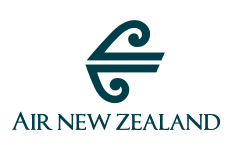 |
||||
|
||||
| Founded | 1940 (as Tasman Empire Airways Limited) 1965 (as Air New Zealand) |
|||
|---|---|---|---|---|
| Hubs | Auckland Airport | |||
| Focus cities |
|
|||
| Frequent-flyer program | Airpoints | |||
| Member lounge | Koru Club | |||
| Alliance | Star Alliance (1999) | |||
| Subsidiaries |
|
|||
| Fleet size | 99 (+28 orders and 33 options) incl. subsidiaries | |||
| Destinations | 53 incl. subsidiaries | |||
| Company slogan | Amazing journeys. Every day. | |||
| Parent company | New Zealand Government (76.07% owner)[1] | |||
| Headquarters | Western Reclamation, Auckland City, New Zealand[2] | |||
| Key people |
|
|||
| Revenue | ||||
| Operating income | ||||
| Profit | ||||
| Total assets | NZ$5,045M (2009)[3] | |||
| Total equity | NZ$1,605M (2009)[3] | |||
| Website | www.airnewzealand.co.nz | |||
Air New Zealand Limited (ASX: AIZ, NZX: AIR) is the national airline and flag carrier of New Zealand. Based in Auckland, New Zealand, the airline operates scheduled passenger flights to 27 domestic destinations and 26 international destinations in 14 countries across Asia, Europe, North America and Oceania,[4] and is currently the only airline to circumnavigate the world.[5] Air New Zealand is a member of the Star Alliance global airline alliance, having joined in 1999.[4]
Air New Zealand's route network focuses on Australasia and the South Pacific, with long-haul services to Asia, Europe and North America. The airline's main hub is Auckland Airport, located near Mangere in the southern part of the Auckland urban area.[6] Air New Zealand is headquartered in a building called "The Hub", located 20 km (12 mi) away from Auckland Airport, in the Western Reclamation, central Auckland City.[7]
Air New Zealand originated in 1940 as Tasman Empire Airways Limited (TEAL), a flying boat company operating trans-Tasman flights between New Zealand and Australia. TEAL became wholly owned by the New Zealand government in 1965, whereupon it was renamed Air New Zealand. The airline was largely privatised in 1989, but returned to majority government ownership in 2001 after a failed tie up with Australian carrier Ansett Australia (when Ansett suffered financial issues and folded operations during that year). As of 2008, Air New Zealand carries 11.7 million passengers annually.[4]
New Zealand's national airline operates a long-haul fleet consisting of Boeing 747, Boeing 767, Boeing 777 and Airbus A320 aircraft on international routes. The carrier also utilises a fleet of Airbus A320 and Boeing 737 airliners for short-haul operations. Air New Zealand's regional subsidiaries, Air Nelson, Eagle Airways, Mount Cook Airline, operate additional short-haul New Zealand domestic services. Air New Zealand was rated the eighth best airline in the world by Skytrax in 2009,[8] and awarded Airline of the Year in 2010 by the Air Transport World Global Airline Awards.[9]
Contents |
History

Air New Zealand began as TEAL (Tasman Empire Airways Limited) in 1940, operating Short Empire flying boats on trans-Tasman routes. Following World War II, TEAL operated weekly flights from Auckland to Sydney, and added Wellington and Fiji to its routings. The New Zealand and Australian governments purchased 50% stakes in TEAL in 1953,[10] and the airline ended flying boat operations in favor of propeller airliners by 1960. With the introduction of the DC-8 in 1965, TEAL became Air New Zealand—the New Zealand government having purchased Australia's 50% stake in the carrier.[10]
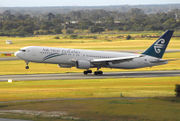
With the increased range of the DC-8s, its first jet aircraft, Air New Zealand began transpacific services to the United States and Asia, and added Los Angeles and Honolulu as destinations in 1965. The airline further acquired wide-body DC-10 airliners, the first of which arrived in 1973.
In 1978, the domestic airline National Airways Corporation (NAC) and its subsidiary Safe Air were merged into Air New Zealand to form a single national airline, further expanding the carrier's operations. In 1981, Air New Zealand added the first Boeing 747 aircraft to its fleet.[10]
In 1982, Air New Zealand initiated service to London, United Kingdom. 1985 saw the introduction of Boeing 767-200ER airliners, and in 1989 the airline was privatised with a sale to a consortium headed by Brierley Investments Ltd.[10] (with remaining stakes held by Qantas, Japan Airlines, American Airlines, and the New Zealand government). The New Zealand air transport market underwent deregulation in 1990, prompting Air New Zealand to acquire a 50% stake in Ansett Australia in 1995. From 1999 through 2000, Air New Zealand became embroiled in an ownership battle over Ansett with co-owner News Limited over a possible sale of the underperforming carrier to Singapore Airlines.
Merger with Ansett
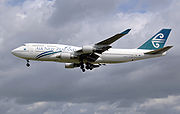
In 2000, Air New Zealand announced that it had chosen instead to acquire the entirety of Ansett Australia (increasing its 50% stake in the carrier to 100%) for $A680 million from News Corporation Ltd. Many believe this to have been a critical mistake, as Ansett's fleet, staffing levels and infrastructure far outweighed that of Air NZ. Subsequently, both carriers' profitability came under question, and foreign offers to purchase the Air New Zealand Group were considered. In September 2001, plagued by costs it could not possibly afford, the Air New Zealand / Ansett Group neared collapse. A failed attempt at purchasing Virgin Blue was the final straw, and on September 12, out of both time and cash, Air New Zealand placed Ansett Australia into voluntary administration, following which Ansett was forced to cease operations. Air New Zealand announced a $NZ1.425 billion operating loss.[10]
Re-nationalised era
In October 2001, Air New Zealand was re-nationalised under a New Zealand government NZ$885 million rescue plan (with the government taking a 76.5% stake), and subsequently received new leadership. This act was the only thing that spared Air New Zealand from also going into administration, without which it too would have joined its now bankrupt subsidiary, Ansett, and likely would have been grounded.
In 2002, Air New Zealand reconfigured its domestic operations under a low-cost airline business plan, and the New Zealand government weighed (and later refused) a proposal from Qantas to purchase a one-fifth stake in the carrier. Air New Zealand returned to profitability in 2003, reporting a net profit of $NZ165.7 million for that year. The carrier saw increasing profits through 2004 and 2005.[10] In 2004, the airline announced a comprehensive relaunch of its long-haul product, featuring the introduction of new seats in its business, premium economy, and economy class cabins. In 2005, Air New Zealand received the first of its newly-ordered Boeing 777-200ER wide-body aircraft, and the airline placed orders for the Boeing 787-9.
In 2009, the airline announced a massive drop in profits due to the global economic crisis and the high oil prices that affected the airline industry during 2008.[3]
Brand and livery
Brand
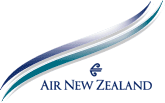
On 27 March 2006, Air New Zealand embarked on a changeover to a new brand identity, involving a new Zambesi-designed uniform, new logo, new colour scheme and new look check-in counters and lounges. The new uniforms feature a colour palette mirroring the greenstone, teal, schist and slate hues of New Zealand, sea and sky (a Māori motif created by Derek Lardelli) fabric woven from merino wool, and curves inspired by the koru. A greenstone colour replaces the blue Pacific Wave colour, inspired by the colour of the pounamu, the prized gemstone found in New Zealand. The Air New Zealand Koru was woven through all Air New Zealand's signage and products.
Later in 2009 staff were involved in testing fabrics and cuts of uniforms. "'It would be fair to say that the lessons from the development and introduction of the current uniform have been taken on board," said Mr. Fyfe after widespread public and staff criticism.[11]
Livery history
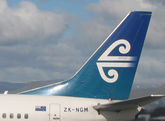
The Air New Zealand Māori symbol is a koru. It is a stylised representation of a fern frond unfolding, and signifies new life, growth and renewal. The koru was used on the prows of the early Polynesian canoes that sailed the Pacific with its many islands.
The koru was first applied to the tail of Air New Zealand aircraft with the arrival of the DC-10 in 1973, and has remained ever since. The current aircraft livery was adopted in 1996. The koru also appears on the Air New Zealand house flag and flies at international airports such as Los Angeles Airport.
A redesigned logo was unveiled on 21 March 2006. The new logo has been introduced in all advertising, signage and stationery and on planes.
Special liveries
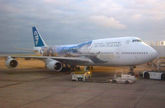
- In 1973, the first McDonnell Douglas DC-10-30s arrived with Christchurch 'NZZN' 1974 Commonwealth Games symbols on both sides of the forward fuselage beneath the cabin windows.
- In 1984, pictures of the Buckingham Palace horse guards with 'London, Here We Come' were placed on the side of the hump of the airline's new Boeing 747-200Bs when Air New Zealand was allowed to fly the Los Angeles - London leg of the trans Pacific route in its own name. Prior to this, British Airways had operated Air New Zealand's aircraft over the US in order to work around a "no pick up and continue" regulation. British Airways was exempt from this regulation.
- A special livery on 747-400 ZK-NBW featuring an image of the All Blacks front row of Carl Hoeft, Anton Oliver and Kees Meeuws was used on the aircraft that took them to the 1999 Rugby World Cup. ZK-NBW also had a black tail. Two other aircraft were painted in the special All Blacks scheme 737-200QC ZK-NQC and Saab 340 ZK-NSK, both these aircraft retained their blue teal tail colours.
- In 1999, one Boeing 737-300 ZK-NGA was painted in a 'New Millenium' livery depicting celebrations and the America's Cup regatta that was to be held in 2000.
- In 2002 and 2003 Air New Zealand marked its position as "the official airline to Middle Earth" by decorating three planes with The Lord of the Rings imagery, applied as giant decals. The decal material was described in airline publicity as being as thin as clingfilm and weighing more than 60 kg. The imagery featured actors from the film trilogy The Lord of the Rings against backdrops of New Zealand locations used in the films.[12][13]
- 2003-2004 saw Freedom Air paint Boeing 737-300 ZK-FRE, Airbus A320-200 ZK-OJL and ZK-OJO in a mural promoting Warner Brothers Movie World on the Gold Coast. All the major Looney Tunes characters were depicted.
- In 2008, ZK-FRE was painted into a lime green Air New Zealand 'Holidays' livery. As of July 2009, the aircraft was removed from Air New Zealand service and sold to WebJet Linhas Aéreas.
Destinations
Air New Zealand flies to 27 domestic destinations and 26 international destinations in 14 countries across Asia, Europe, North America and Oceania.
Apart from flying from hub city Auckland, Air New Zealand also flies the Los Angeles - Heathrow and Hong Kong - Heathrow routes. In December 2009, Air New Zealand announced a new Sydney - Rarotonga service to attract more Australians looking for another South Pacific Island holiday experience in the Cook Islands.[14] Air New Zealand will be the only airline to operate direct services between the two nations. Previously, passengers from Australia must transit in Auckland before connecting onto another flight to Rarotonga. Currently, Air New Zealand already operates out of Rarotonga to Los Angeles.
As of 29 October 2009, Air New Zealand has codeshare agreements with the following airlines:
|
|
Fleet
Air New Zealand's main fleet consists of Boeing jet aircraft for medium- and long-haul international flights, and Boeing and Airbus jet aircraft for domestic and short-haul international flights. Air New Zealand's subsidiaries operate various makes of turboprop aircraft.
The majority of the airline's main fleet is made up of short-haul jet aircraft in the form of Boeing 737-300s and Airbus A320-200s. The fifteen 737-300s are used on domestic routes between the major airports (Auckland, Wellington, Christchurch, Dunedin, Queenstown), and also fly on routes to Niue in the Pacific. The fleet also includes the last 737-300 built, ZK-NGJ, which was delivered to Air New Zealand in December 1999. The twelve A320-200s are used on short-haul international routes to Australia and the Pacific Islands, and are used on all international services to and from New Zealand airports other than Auckland and Christchurch.
Air New Zealand's main international medium-haul (i.e. within the Pacific region) jet aircraft is the Boeing 767-300ER. Five aircraft operate routes to many Pacific Islands, Honolulu and Los Angeles, Osaka, and some flights to Australia including all those to Perth. They all have recently been retrofitted with winglets to increase fuel economy.
The international long-haul fleet consists of Boeing 777-200ER and Boeing 747-400 jet aircraft. The eight 777-200ER aircraft operate on the majority of the long-haul routes, including Asia, North America, London via Hong Kong, and some Pacific Islands. The six 747-400 operate on larger long-haul routes, to London via Los Angeles,Vancouver and Brisbane.
For regional domestic services, three makes of turboprop aircraft are used, each make belonging to a single subsidiary. Mount Cook Airline operates eleven ATR 72-500 aircraft between major centres, such as Hamilton, Palmerston North, Tauranga, Napier, and Invercargill. The 23 Air Nelson-operated Bombardier Q300 operate mainly on major routes alongside Mount Cook Airline, including to some smaller centres. Eagle Airways' eighteen Beechcraft 1900D operate on minor routes between smaller urban areas.
The Boeing customer codes for Air New Zealand is 7x7-x19, which was sequestered from the National Airways Corporation on its merger with Air New Zealand in 1978 (Air New Zealand itself didn't own any Boeing aircraft before 1978). All Boeing aircraft built for Air New Zealand are designated with the customer code, so a Boeing 777-200ER built for Air New Zealand is designated a 777-219ER.
Current fleet
Main fleet
| Aircraft | In service | Orders | Options | Passengers | Routes | Notes | ||||||
|---|---|---|---|---|---|---|---|---|---|---|---|---|
| Total | F | B | P | S | C | E | ||||||
| Airbus A320-200 | 12 | 14 | 11 | 144 | 8 | 36 | 108 | Adelaide, Brisbane, Cairns, Gold Coast, Melbourne, Nadi, Norfolk Island, Nouméa, Port Vila, Rarotonga, Samoa, Sydney, Tonga | Replacing Boeing 737-300 aircraft from 2011 To be reconfigured to 171 seats Space+/Economy from November 2010 [15] |
|||
| Boeing 737-300 | 15 | — | — | 133 | 67 | 66 | Niue and domestic | Exit from service: 2011 to be replaced by Airbus A320-200[16] |
||||
| Boeing 747-400 | 5 | — | — | 379 | 46 | 39 | 294 | Brisbane, London-Heathrow via Los Angeles | Exit from service: 2010 to be replaced by Boeing 777-300ER One extra sold for parts (ZK-NBS), one extra stored at Auckland (ZK-NBT) and one extra sold (ZK-SUI) |
|||
| Boeing 767-300ER | 5 | — | — | 223 244 |
24 24 |
46 0 |
153 210 |
Brisbane, Cairns, Honolulu, Los Angeles, Nadi, Osaka, Perth, Rarotonga, Samoa, Sydney, Tonga | Eventually to be replaced by Boeing 787-9 | |||
| Boeing 777-200ER | 8 | — | — | 304 | 26 | 36 | 242 | Beijing, Brisbane, London-Heathrow via Hong Kong or Los Angeles, Melbourne, Nadi, Rarotonga, San Francisco, Shanghai, Tokyo-Narita, Vancouver | To be re-fitted with new long-haul cabin (with new seats and SkyCouch) from mid-2011 | |||
| Boeing 777-300ER | — | 5 | 2 | 338 | 44 | 50 | 60 | 184 | Brisbane, London-Heathrow via Los Angeles (from 2 April 2011) | Entry into service: November 2010 Replacing: Boeing 747-400 |
||
| Boeing 787-9 | — | 8 | 8 | 250-290 estimated | TBA | Entry into service: 2013 | ||||||
Subsidiaries fleet
| Aircraft | In Service | Orders | Options | Passengers (all economy) |
|
|---|---|---|---|---|---|
| ATR 72-500 | 11 | - | - | 68 | Operated by Mount Cook Airlines |
| Beechcraft 1900D | 18 | 1 | - | 19 | Operated by Eagle Airways |
| Bombardier Q300 | 23 | - | - | 50 | Operated by Air Nelson |
| Total | 52 | 1 | 0 |
Fleet gallery
|
Airbus A320-200 ZK-OJI at Rarotonga International Airport |
 Boeing 737-300 ZK-NGM landing at Dunedin International Airport |
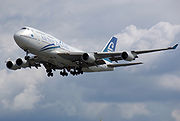 Boeing 747-400 ZK-SUJ, landing at London Heathrow Airport |
 Boeing 767-300ER ZK-NC? landing at Auckland Airport |
 Boeing 777-200ER ZK-OKB, landing at London Heathrow Airport |
Mount Cook Airline ATR 72-500 ZK-MCY at Auckland Airport |
Air Nelson Bombardier Q300 ZK-NE? at Hawke's Bay Airport |
Eagle Airways Beechcraft 1900D ZK-EAP at Palmerston North International Airport |
Future fleet plans
Air New Zealand announced on 3 November 2009 that it would replace its aging Boeing 737-300 fleet with fourteen new Airbus A320-200 aircraft, with options on eleven more A320s and/or larger A321s. The new aircraft, seating 171 passengers and powered by IAE V2500 engines, will take over the domestic routes operated by the 737-300 and are expected to be introduced from 2011.[16][17][18] Air New Zealand chose the A320 over the rival Boeing 737-800 on grounds of better fuel economy, lower pricing in purchasing, and lower running costs (due to the commonality with the airline's existing A320 short-haul international fleet).[18] Air New Zealand will also be the launch airline for the new "sharklet" winglets that are due to be added to the Airbus A320 family in 2012, decreasing fuel burn by 3.5 percent and cutting carbon emissions.[19][20]
The airline has ordered five Boeing 777-300ER aircraft to replace its Boeing 747-400 fleet, with options on two more.[21] The new aircraft are expected to be delivered from 2010. Meanwhile, Air New Zealand, due to the economic downturn and the rise in fuel prices, has stored 747-400 ZK-NBT. It has also has disposed of pioneering bio-fueled aircraft ZK-NBS to be broken up for parts - the first 747-400 to be scrapped and sold ZK-SUI
Air New Zealand has ordered eight Boeing 787-9s as the launch customer for the 787-9 model, with options on eight more.[22] The first aircraft are expected to be delivered in 2013, replacing the Boeing 767-300ER aircraft. The airline has received delays due to Boeing delaying the aircraft for a third time. As launch customer for the 787-9, Air New Zealand is seeking compensation for these delays with the possibility of being leased the smaller 787-8 as an interim type. It has also been approached as the 787-10 launch customer to take on the Airbus A350, a type that Airbus has wooed Air New Zealand with back to buying that company's products.
Recent study programmes have been underway to replace Mount Cook Airline's ATR 72-500 fleet. In October 2008, the program was suspended, while in the meantime the airline has purchased its eight leased aircraft outright giving them total fleet ownership. Possible replacement aircraft include the Bombardier Q400, the Embraer E-190 & E-195, and the ATR 72-600.
Retired
Air New Zealand or its predecessors (NAC and TEAL) have operated:[23]
|
|
Head office
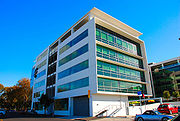
The Air New Zealand head office, "The Hub," is a 15,600 square metres (168,000 sq ft) office park located at the corner of Beaumont and Fanshawe Streets in Western Reclamation Precinct 2, Auckland City;[24][25] it includes two connected six level buildings.[25] The facility consists of a lot of glass to allow sunlight and therefore reduce electricity consumption. The building does not have cubicle walls. Lights automatically turn on at 7:30 A.M. and turn off at 6 P.M. Sensors throughout the building can turn on lights if they detect human activity, and turn off lights if human activity is not detected for 15 minutes.[26] The building cost $60 million New Zealand dollars to build and develop. From late September to early October 2006 the airline moved 1,000 employees from four buildings in the Auckland CBD and some other buildings.[25] The company previously had its head office in the Quay Tower in the CBD.[27] "The Hub" is owned by Macquarie Goodman Property Trust. In 2006 the airline took an initial 11 year lease for 4.1 million dollars each year; the rent cost is subject to a yearly review to account for increases in property value.[25]
Services
Onboard
Cabin classes
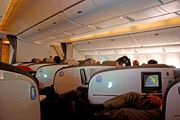
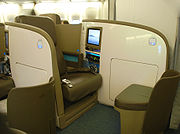
On 28 June 2004, Air New Zealand released details of the upgrade to their long-haul product, which was aimed to turn around the profitability of its international services. Every seat on their Airbus A320-200, Boeing 767-300ER, Boeing 777-200ER and Boeing 747-400 aircraft is equipped with a personal LCD screen with audio video on demand. First class was removed, with an upgraded business class and a new premium economy section installed.
Business Premier (business class) features a seat that unfolds into a flat bed. The seats are configured in a herringbone layout (a variation on the Virgin Atlantic Airways Upper Class seat, which was paid licensing fees for use of the concept; similarly used on Air Canada and Cathay Pacific). Each seat has direct aisle access. This service is available on the Boeing 747-400 and Boeing 777-200ER aircraft only, on most long-haul routes and some Tasman and Pacific flights.
Business Class (Business class) Standard business class seat equipped on Boeing 767-300ER which are unable to take the lie flat bed but have most of the amenities provided in Business Premier Class.
Pacific Premium Economy (premium economy) is in a dedicated cabin, which shares lavatories with the Business Premier cabin, available only on the Boeing 747-400 and Boeing 777-200ER. The class has the same mood lighting, dining and wine selection and in-seat power as the Business Premier cabin. On the 747-400 the seats are wider than Pacific Class, while on the 777 the seat width is the same as in Economy but with greater pitch; all seats have more legroom than standard Economy. Following positive reviews and high demand after its introduction, Air New Zealand re-launched its Pacific Premium cabin with added business class services, including priority check-in, priority baggage handling and the same baggage allowance as Business Premier (priority baggage handling and extra baggage allowance do not apply for passengers with connecting flights to other airlines). Seat pitch is approximately 39 in (990 mm).
Pacific Economy (economy class) has a new generation seat design with added space. The seats have a flexible edge seat base to provide more leg support when reclined, and an 8.4" personal LCD screen. Entertainment modules were moved to the side for more legroom. Seat pitch is up to 34 in (860 mm) depending on aircraft.
Space+ seating (economy class) is located toward the front of A320-200, 737-300, and 767-300ER cabins providing extra legroom for full fare paying and preferred passengers on domestic and some international services.
New cabin
In January 2010, Air New Zealand introduced its new interior design, including lie-flat economy and more comfortable premium seats, to media representatives. Designed in-house, the new cabins will be first introduced on the 777-300ER in November 2010, and applied to existing 777-200ER and forthcoming 787-9 aircraft.[28][29] In Economy class on the 777-300ER, the first 11 window rows of Economy class will feature a "Skycouch" configuration, where a row of three seats can be turned into one of 22 horizontal lie-flat beds for two adult passengers.[29] The Skycouches were designed with couples or families in mind, providing space for kids to play. The cost of being able to lie flat will be about US$200 more than the lowest economy seat, along with the cost of the third seat at half price.[29]
Changes to Premium Economy include new seats in herringbone-configuration, more legroom, and shared-meal experiences for people wanting to travel together or a more social flying experience.[30] Food and beverage was also a focus for Business Premier cabins, which include on-demand services, along with an “enhanced sleep experience.”[31] The 777-300ER aircraft will include 246 Economy seats (including 66 seats that will create the Skycouch combinations), 50 in Premium Economy and 44 in Business Premier. Bar-style galleys with video display screens will also be installed,[29] allowing for in-flight wine tastings, children's storytime, made-to-order meals and seminars on the flights destinations aimed at providing passengers with information on attractions and activities in their destination, performed by the cabin crew.[28]
In-flight entertainment and magazine
Air New Zealand offers audio video on demand (AVOD) in all classes on international services on its 747-400, 777-200ER, 767-300ER, and A320-200 aircraft. The first AVOD system was introduced on all its 747's and 777's manufactured by Rockwell Collins, and the rest was manufactured by Panasonic Avionics Corporation enhanced with a touch-screen functionality.
The AVOD system, branded KiaOra, features multiple channels of video, audio, music, and games. Passengers can start and stop programs, plus rewind and fast-forward as desired. Recently, Air New Zealand has introduced a gate-to-gate in-flight entertainment experience. Passengers can start up their entertainment as soon as they boarded the plane, right until they arrive at the gate of their destination, maximizing play time especially useful for its short-haul Tasman and Pacific Island flights. Gate-to-gate IFE is not available on certain seats in economy (such as the bulkhead and emergency exit row seats), and on all Business Class seats on its 767's as they use fold-out PTV.
AVOD screen size differs every class:[32]
- Business Premier: 10.4 in (260 mm)
- Pacific Premium Economy: 8.4 in (210 mm)
- Pacific Economy: 8.4 in (210 mm)
KiaOra, the airline's in-flight magazine, was removed from international flights from March 2009. It is now only on-board on all the domestic services. As a guide on international services, there is now a brief publication named Entertainment Magazine detailing the entertainment available on the flight.
Inflight Concierge
Air New Zealand have in-flight concierge staff on selected long-haul international flights, whose function is to advise passengers personally on travel advice, onward bookings, and other services relating to their travel itinerary. The service is available on routes between Auckland and Vancouver, San Francisco and Los Angeles as well as from Los Angeles to London Heathrow and is available to all passengers on board.[33][34]
Koru Lounge & Koru Club
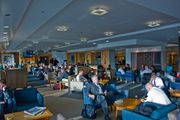
The Koru Lounge is the name for Air New Zealand's network of airline lounges in New Zealand and Internationally. To access the lounge you are required to be a member of Air New Zealand Koru Club. Along with access to the lounges Koru Club members get travel perks such as Valet Parking, Priority Wait listing, exclusive check-in, extra checked in baggage, and preferred seating.
Check-in kiosks
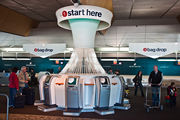
This was launched in October 2008 at Auckland Domestic terminal. Users use a bar code issued on line or via mobile or PDA to scan for checking in. Most business day travellers can go straight through to their departure gate if not checking in bags. Wellington and Christchurch were equipped in late November 2008 while the larger provincial cities were retrofitted with a smaller system. Smaller destinations received an ATM sized machine (for the Beech 1900D network).
The proportion of Air New Zealand’s passengers using self-service check-in is increasing. Following the launch of its domestic product, the airline reached its 80% self-service target three days after going live.[35] That has continued to grow to the stage that the number of full-service customers traveling within its domestic network has reduced to a trickle. These self-service kiosks are now also available for travel out of the Auckland International terminal, allowing passengers to self check-in with baggage.
Check-in kiosks are manufactured by IER (www.ier.aero)
Airpoints
Airpoints is Air New Zealand's Frequent Flyer programme. Members earn Airpoints Dollars, which they can redeem at face value on any fare on every Air New Zealand ticketed and operated flight. Members are assigned a tier status, with increasing privileges ranging from Jade, Silver to Gold, then Gold Elite by accumulating their Status Points which is earned separately from the Airpoints Dollars. Becoming an Airpoints Gold and Airpoints Gold Elite would have the same recognition as a Star Alliance Gold status and benefits across the Star Alliance network. The same goes with the Airpoints Silver and Star Alliance Silver, only with less benefits. There is a joining fee of NZD 50 to be paid if the enrolling member has never joined. Otherwise, if one has already flown Business Class by Air New Zealand and can prove that, he or she can join Airpoints free of charge.
Status Points
Air New Zealand's Airpoints members now will receive Status Points for almost every Air New Zealand flight, as well as many other flights with its Star Alliance partners. Status Points enable Airpoints members reach a higher tier status faster. Status Points will still be granted even on discount fares (such as Smart Saver and grabaseat fares) that normally do not earn Airpoints Dollars.[36]
Awards
- Airline of the Year - 2010 Air Transport World Global Airline Awards[9]
- Best Cabin Staff Australia/NZ Region - 2009 World Airline Awards, Skytrax[37]
- Best Passenger Service Award - 2008 Air Transport World magazine awards[4]
- Best Airline to the South Pacific, Australia, and New Zealand in December 2007 by Business Traveler Magazine in the United States[4]
- Australasia's Leading Business Class Airline at the 14th Annual World Travel Awards 2007[4]
- Best Pacific Airline - 1998, 1999, 2000, 2001, 2002, 2004 TTG Annual Travel Awards[10]
- Best Airline to the Pacific - 1994, 1995, 1996, 1999, 2000, 2001Travel Weekly Globe Awards[10]
- Best Business Class Carrier, Best Check-in Staff, 1998 Executive Travel magazine awards[10]
Subsidiaries
Operations subsidiaries
The following are operations subsidiaries of Air New Zealand Limited:
- Air New Zealand Consulting
- Air New Zealand Holidays
- Air New Zealand Cargo
Air New Zealand has four wholly-owned subsidiary airlines:
Three are fully-integrated regional airlines – Air Nelson, Eagle Airways and Mount Cook Airline – which serve secondary destinations in New Zealand. Together they make up Air New Zealand Link.
- Air Nelson is based in Nelson, operating Bombardier Q300s. Flight numbers are in the NZ8000 series.
- Eagle Airways is based in Hamilton, operating Beechcraft 1900D aircraft. Flight numbers are in the NZ2000 series.
- Mount Cook Airline is based in Christchurch, operating ATR 72-500 turboprop aircraft. Flight numbers are in the NZ5000 series.
- Zeal320 was introduced to help combat increasing labour costs. Zeal320 operates Air New Zealand's trans-Tasman fleet of Airbus A320-200 aircraft under the Air New Zealand brand. On 31 July 2006, flights were re-numbered to the NZ700-999 series for Trans-Tasman services, and NZ1000 series for Domestic services. All of Air New Zealand's A320-200s were registered to Zeal320 until 26 November 2008, when ownership of the fleet was transferred back to Air New Zealand. However staff that work the A320-200 fleet are still employed by this subsidiary. This has been a bone of contention within the airline group in which these employees are paid at a lower scale than their mainline counterparts.[38] Continued industrial action by staff employed in this subsidiary during 2009 have delayed a proposed LCC airline as a successor to Freedom Air that would have also employed the Airbus A320 on domestic routes to counter the likes of Jetstar Airways and Pacific Blue now operating in New Zealand.
Air New Zealand also uses air charter operators Air National and Vincent Aviation, complementing Eagle Airways on selected provincial routes using British Aerospace Jetstream 32, and Beechcraft 1900C aircraft respectivley.
Technical subsidiaries
The following are technical operations subsidiaries of Air New Zealand:
- Air New Zealand Engineering Services
- TAE
- Safe Air New Zealand
- Safe Air Australia
- Christchurch Engine Centre (50%)
- Altitude Aerospace Interiors
Safe Air Australia is a subsidiary of Safe Air New Zealand.
Incidents and accidents
As of June 2010, Air New Zealand and its subsidies have been involved in over ten incidents and accidents, including 5 hull loss accidents.
- On 4 July 1966, an Air New Zealand Douglas DC-8 on a training flight crashed on the runway shortly after taking off, killing two of the five crew (no passengers were on board).[39][40]
- On 17 February 1979, an Air New Zealand Fokker Friendship crashed into Manukau Harbour while on final approach. One of the crew and one company staff member were killed.[41]
- On 28 November 1979, Air New Zealand Flight 901, a McDonnell Douglas DC-10-30-operated sightseeing flight over Antarctica, collided with Mount Erebus on Ross Island, killing all 257 people on board. An unannounced change in flight path coordinates by the airline's navigational division the morning of the accident, combined with unique Antarctic weather and conditions, resulted in the aircraft crashing into Mount Erebus when the flight crew thought they were flying down McMurdo Sound. The crash and subsequent inquiry resulted in major changes in Air New Zealand's management.
- On 19 May 1987, during the first of Fiji's coups d'état that year, Air New Zealand Flight 24, a Boeing 747-200-operated flight from Tokyo Narita to Auckland via Nadi, was hijacked at Nadi International Airport. Staff members of the local ground handling crew stormed the plane, and held three flight crew hostage for six hours before the incident was resolved. Air New Zealand subsequently suspended all of its services to/through Nadi for seven months.[10]
- On 29 March 1995, NZ2337 from Hamilton to New Plymouth operated by a Kiwi West Aviation Beech Queen Air B80 Excalibur for Air New Zealand crashed 13 minutes after take-off killing all six on board. The plane stalled and spun after both engines failed due to fuel starvation.[42]
- On 18 June 2007, Air New Zealand/Eagle Airways Flight 2300, a Beechcraft 1900D-operated flight from Timaru to Wellington, was diverted to Woodbourne Aerodrome near Blenheim after the landing gear failed to deploy on the approach to Wellington.[43] The aircraft landed on its belly, causing extensive but repairable damage to the aircraft. None of the 17 people on board were injured. The cause was the hydraulic system being drained via a fatigue crack in the hydraulic actuator for the right main landing gear, resulting in the gear being stuck in the retracted position.[44]
- On 8 February 2008, a woman attempted to hijack Air New Zealand Flight 2279 from Blenheim to Christchurch. Though this was actually an Air National J32 on charter to replace the normal Eagle aircraft.The woman threatened Air New Zealand staff, stating she had a bomb on board. Both pilots and one passenger suffered stab injuries. The aircraft landed safely and the woman was arrested.There were no injuries to the other passengers on board.[45][46]
- On 27 November 2008, (28 November New Zealand time) a leased Air New Zealand-owned Airbus A320-200 (ZK-OJL) registered D-AXLA, on a post-maintenance flight (flight GL888T) crashed into the Mediterranean Sea seven kilometers east of the French city of Perpignan, near the border with Spain. The seven people on board were killed, including four Air New Zealand representatives. The aircraft was on lease to XL Airways Germany, a European-based airline. ZK-OJL was unique in that when sequestered to Freedom Air, was painted in a remarkable Warner Brothers cartoon character colour scheme.
Controversial topics
Outsourcing maintenance
On 19 October 2005, Air New Zealand proposed outsourcing most of its heavy maintenance on its long-haul aircraft and engines, which would result in about 600 job losses, mostly in Auckland. Air New Zealand said that there are larger maintenance providers who can provide maintenance work cheaply due to their large scale. The proposal was estimated to save $100 million over five years and came after many attempts to attract contracts to service other airlines' longhaul aircraft.
Eventually, a union proposal to save some of the remaining jobs was accepted. The proposal included shift and pay changes (most of them pay-cuts) which would allow about 300 engineers in Auckland to keep their jobs. 200 were made redundant or resigned.[47]
Minor seating policy
In November 2005, it was revealed that Air New Zealand (along with Qantas & British Airways) has a policy of not seating adult male passengers next to unaccompanied children. The policy came to light following an incident in 2004 when Mark Wolsay, who was seated next to a young boy on a Qantas flight in New Zealand, was asked to change seats with a female passenger. A steward informed him that "it was the airline's policy that only women were allowed to sit next to unaccompanied children". Air New Zealand later said it had a similar policy to Qantas, attracting widespread criticism [48][49]
On 12 April 2006, Air New Zealand and Qantas announced that they had signed a code-share agreement for their trans-Tasman routes and would file for authorisation from the New Zealand Ministry of Transport[50] and the Australian Competition and Consumer Commission.[51] The airlines maintained that they were making losses on Tasman routes due to too many empty seats, and that a codeshare would return the routes to profitability. Critics, particularly Wellington International Airport and Melbourne Airport, argued that the codeshare would lead to reduced passenger choice and higher airfares, and that the airlines were exploiting an effective duopoly on the Tasman routes.
On 15 November 2006 Air New Zealand announced it was withdrawing its application after a draft decision by the Australian Competition and Consumer Commission to not approve the code-sharing agreement.
Nothing to Hide campaign
On 10 May 2009, Air New Zealand launched a controversial and widely publicized TV advertising campaign, Nothing to hide.
The campaign featured more than ninety Air New Zealand staff, eight of whom were chosen for starring roles and who swapped their real uniforms for a body painted version. Chief Executive Officer Rob Fyfe made a cameo appearance in full body-paint.[52][53]
The campaign was designed to differentiate Air New Zealand from low-cost competitors who levy additional charges if a passenger wants to check a bag or have a drink. Air New Zealand have airfares that include baggage allowances and refreshments.
The TV commercial was accompanied by a new in-flight safety video using the same theme. The safety video, titled Bare Essentials, is shown on all Boeing 737-300-operated flights. It features a pilot and four cabin staff.[54][55] Another version was released later, this time for the Airbus A320.[56]
The TV ad and in-flight safety video both use the track "Under My Skin" by New Zealand singer Gin Wigmore.
Both videos can be viewed on the campaign website Nothing To Hide, complete with bloopers and behind the scenes. On YouTube the TV commercial has attracted almost 4 million views and the in-flight safety video gathered over 4.5 million. The campaign has been reported by international networks such as CNN and the BBC.
In late 2009 Air New Zealand started to put up billboard ads where a body painted staff member was walking into a carwash or ready to go down a water slide or even ready to jump off a diving board.
'Dear Listener' campaign
In May 2010, the New Zealand Listener magazine had put an article on the Air New Zealand - Virgin Blue trans-Tasman alliance that suggested that due to budget constraints, Air New Zealand would be downgrading its services into a no-frills airline. Air New Zealand subsequently published their responses in sign language advertisements in various newspapers, including The Dominion Post, and posted the translation on a website, http://www.dearlistener.co.nz.
Alternative propulsion
In the effort to develop an aviation biofuel, Air New Zealand and Boeing are researching the jatropha plant to see if it is a green alternative to conventional fuel.[57] A two-hour test flight using a 50-50 mixture of the new biofuel with Jet A-1 in the number one position Rolls Royce RB-211 engine of 747-400 ZK-NBS, was completed on 30 December 2008. The engine was then removed to be scrutinised and studied to identify any differences between the Jatropha blend and regular Jet A1. No effects to performances were found. However Air New Zealand took the opportunity to retire ZK-NBS due to the economic global slowdown in 2009.[58]
Sponsorships
Air New Zealand was the title sponsor of the Air New Zealand Cup domestic rugby club competition through the 2009 season.[59] The airline remains a major sponsor of New Zealand rugby, but chose to concentrate its sponsorship in that area on the country's national team, the All Blacks.[60] The airline also sponsors the Air New Zealand Wine Awards and the Air New Zealand Fashion Export Award.[61]
Other major sponsorship by Air New Zealand:
See also
- Ansett Australia
References
- ↑ "Shares on Issue". http://airnewzealand.co.nz/aboutus/corporateprofile/shares_on_issue/default.htm. Retrieved 2009-03-28.
- ↑ "Airline Membership". IATA. http://www.iata.org/membership/Pages/airline_members_list.aspx?All=true.
- ↑ 3.0 3.1 3.2 3.3 3.4 3.5 "Air New Zealand - 2009 Annual Financial Report". http://www.airnewzealand.co.nz/resources/2009-annual-financial-report.pdf. Retrieved 2009-10-15.
- ↑ 4.0 4.1 4.2 4.3 4.4 4.5 Air New Zealand - Star Alliance Member Airline profile
- ↑ Does any one airline fly all the way around the world?
- ↑ "Directory: World Airlines". Flight International: p. 64. 2007-03-27.
- ↑ "We're committed to our environment." Air New Zealand. 21 (23/29). Retrieved on 26 August 2009.
- ↑ "Air NZ slips in world rankings". Fairfax New Zealand. 12 August 2009. http://www.stuff.co.nz/travel/576916. Retrieved 4 September 2009.
- ↑ 9.0 9.1 Awarded ATW Airline of the Year
- ↑ 10.0 10.1 10.2 10.3 10.4 10.5 10.6 10.7 10.8 10.9 "Air New Zealand History" (pdf). Air New Zealand. http://www.airnz.co.nz/resources/company_history_feb_06.pdf. Retrieved 2007-02-28.
- ↑ McNabb, Denise (4 May 2009). "Fyfe memo reveals Air NZ revamp". The Dominion-Post (Fairfax New Zealand). http://www.stuff.co.nz/dominion-post/business/2381824/Fyfe-memo-reveals-Air-NZ-revamp-and-jazz-up-plans. Retrieved 2009-05-04.
- ↑ Air New Zealand - Official airline to Middle-earth (press release) 14 December 2002
- ↑ Return of Aragorn and Legolas: Air New Zealand Debuts Newest Flying Billboard 19 November 2003
- ↑ Air New Zealand Announces Sydney - Rarotonga Services
- ↑ "Air New Zealand to transform its Tasman and Pacific Island Services". 2010-03-18. http://www.airnewzealand.co.nz/press-release-2010-air-new-zealand-to-transform-its-tasman-and-pacific-island-services. Retrieved 2010-06-26.
- ↑ 16.0 16.1 "Air NZ to replace domestic fleet with A320s". tvnz.co.nz. 2009-11-03. http://tvnz.co.nz/business-news/air-nz-replace-domestic-fleet-a320s-3110146. Retrieved 2009-11-05.
- ↑ "Air New Zealand orders Airbus A320s to replace Boeing 737-300s". Airbus. 2009-11-03. http://www.airbus.com/en/presscentre/pressreleases/pressreleases_items/09_11_03_a320_air_new_zealand.html. Retrieved 2009-11-15.
- ↑ 18.0 18.1 "Air NZ says A320 choice came down to the wire". nzherald.co.nz. 2009-11-04. http://www.nzherald.co.nz/air-new-zealand/news/article.cfm?o_id=5&objectid=10607114. Retrieved 2009-11-16.
- ↑ "Air New Zealand launches Airbus A320 Winglets". Bloomberg. 2009-11-16. http://www.bloomberg.com/apps/news?pid=20601100&sid=ao0G1cVV0H3s. Retrieved 2009-11-16.
- ↑ "Airbus launches “Sharklet” large wingtip devices for A320 Family with commitment from Air New Zealand". Airbus. 2009-11-15. http://www.airbus.com/en/presscentre/pressreleases/pressreleases_items/09_11_15_a320_sharklet_new_zealand.html. Retrieved 2009-11-16.
- ↑ ANZ orders up to seven 777-300ERs to replace 747-400s
- ↑ Air NZ orders four more Dreamliners
- ↑ Air New Zealand Company History (PDF)
- ↑ Taylor, Colin. "Big piece of Viaduct for little guys." New Zealand Herald. Saturday 21 October 2006. Retrieved on 5 March 2010.
- ↑ 25.0 25.1 25.2 25.3 Gibson, Anne. "Air NZ readies for headquarters shift." The New Zealand Herald. Monday 14 August 2006. Retrieved on 26 August 2009.
- ↑ Pae, Peter. "Air New Zealand touts being green, quirky." Los Angeles Times. 10 October 2008. 3. Retrieved on 26 August 2009.
- ↑ "Directory: World Airlines." Flight International. 16–22 March 2004. 70.
- ↑ 28.0 28.1 Wein, Kent. "Coach cabin revolution -- Air New Zealand adds beds in economy". Gadling.com. http://www.gadling.com/2010/01/25/coach-cabin-revolution-air-new-zealand-adds-beds-in-economy/. Retrieved 2010-01-26.
- ↑ 29.0 29.1 29.2 29.3 Van der Bergh, Roeland. "Sharing Air New Zealand's Skycouch". Stuff.co.nz. http://www.stuff.co.nz/business/industries/3262044/Sharing-Air-New-Zealands-Skycouch. Retrieved 2010-01-26.
- ↑ Air New Zealand Revolutionizes the Economy Seat With Skycouch
- ↑ Air New Zealand - Future Taking Flight
- ↑ "In-flight Entertainment". Air New Zealand. http://www.airnewzealand.co.nz/inflight-entertainment.
- ↑ Bradley, Grant (2007-12-11). "Air NZ hires world's first in-flight concierges". New Zealand Herald. http://www.nzherald.co.nz/section/1/story.cfm?c_id=1&objectid=10481686. Retrieved 2007-12-12.
- ↑ "Air New Zealand International Airline Concierge Service". Air New Zealand. 2009. http://www.airnewzealand.co.nz/on-the-plane/inflight-concierge-service.htm.
- ↑ "Air New Zealand highlights value of a successful self-service strategy". Check-In News, Analysis & Event. http://www.check-in.aero/2010/08/air-new-zealand-highlights-value-of-a-successful-self-service-strategy/.
- ↑ "Air NZ Status Points". Air New Zealand. 2009. http://www.airnewzealand.co.nz/airpoints/status_points/default.htm.
- ↑ A-Z INDEX OF WORLD AIRLINE AWARD WINNERS
- ↑ NZ CAA list of registered Airbus A320s retrieved 28 November 2008.
- ↑ Cranston, Mark (April 2006). "Air New Zealand DC-8 Digest". Simviation Historic Jetliners Group. http://www.simviation.com/hjg/articles/0604_anz_dc8_digest.htm. Retrieved 2007-09-17.
- ↑ "ASN Aircraft accident description Douglas DC-8-52 ZK-NZB - Auckland International Airport (AKL)". Aviation Safety Network. 2005-02-27. http://www.aviation-safety.net/database/record.php?id=19660704-0. Retrieved 2007-09-18.
- ↑ "ASN Aircraft accident Fokker F-27 Friendship 500 NK-NFC Manukau Harbour". Aviation Safety Network. 2005-02-27. http://aviation-safety.net/database/record.php?id=19790217-1&lang=en.
- ↑ "Major Carriers". http://www.oreillylaw.com/major_carriers.htm. Retrieved 2007-11-11.
- ↑ "Belly landing at Blenheim airport". http://tvnz.co.nz/content/1187269/423466.html.
- ↑ [Gskins/taicAviation/skin_aviation "Report 07-006, Hawker Beechcraft Corporation 1900D, ZK-EAK, landing gear malfunction and subsequent wheels-up landing, Woodbourne Aerodrome, Blenheim, 18 June 2007"]. Transport Aciident Investigation Commission. http://www.taic.org.nz/ReportsandSafetyRecs/AviationReports/tabid/78/ctl/Detail/mid/482/InvNumber/2007-006/Page/0/language/en-US/Default.aspx?SkinSrc=[G]skins/taicAviation/skin_aviation. Retrieved 2010-05-23.
- ↑ "Witness: Airport drama 'like a Bruce Willis movie'". The New Zealand Herald. http://www.nzherald.co.nz/section/1/story.cfm?c_id=1&objectid=10491315.
- ↑ "Police identify woman who attacked pilots on flight". The New Zealand Herald. http://www.nzherald.co.nz/section/1/story.cfm?c_id=1&objectid=10491291.
- ↑ "Air NZ engineers accept deal". New Zealand Herald. 24 February 2006. http://www.nzherald.co.nz/section/story.cfm?c_id=1&ObjectID=10369829.
- ↑ "Airline Bars Men From Lone Children". peterellis.org.nz. 2009-11-29. http://www.peterellis.org.nz/MoralPanic/Airline/2005-1129_NewstalkZB_AirlineBars.htm. Retrieved 31 July 2010.
- ↑ Thomson, Ainsley (2005-11-29). "Ban on men sitting next to children". The News Zealand Herald. http://www.nzherald.co.nz/section/1/story.cfm?c_id=1&ObjectID=10357510. Retrieved 31 July 2010.
- ↑ International air carriage competition
- ↑ Qantas Airways Ltd & Air New Zealand Ltd - Authorisations
- ↑ Air New Zealand's "Nothing to Hide" TV Ad Campaign goes live
- ↑ Air NZ staff have nothing to hide
- ↑ Safety In-flight - The Bare Essentials
- ↑ Air NZ Bare Essentials of Safety in-flight video
- ↑ http://www.youtube.com/watch?v=diytGIKwC6U
- ↑ "Air NZ sees biofuel salvation in jatropha". Carbonpositive.net. 6/608. http://www.carbonpositive.net/viewarticle.aspx?articleID=1114. Retrieved 31 July 2010.
- ↑ "Vegetable oil tested on NZ flight". BBC News. 31 December 2008. http://news.bbc.co.uk/2/hi/science/nature/7805499.stm. Retrieved 2008-12-31.
- ↑ "Air New Zealand Cup". Air New Zealand. 2009. http://www.airnewzealand.co.nz/aboutus/sponsorship/sports/airnz_npc.htm.
- ↑ New Zealand Rugby Union (2010-03-15). "ITM Cup the new prize of national provincial rugby". Press release. http://www.itmcup.co.nz/itmCupNews/12412/ITM-Cup-the-new-prize-of-national-provincial-rugby-. Retrieved 2010-05-21.
- ↑ "Air New Zealand Wine Awards". Air New Zealand. 2009. http://www.airnewzealand.co.nz/aboutus/sponsorship/artsandculture/wine/airnz_wine_awards.htm.
External links
- Air New Zealand
- AirNZ.mobi Air New Zealand mobile site
- Air New Zealand at YouTube
- Nothing to Hide
- Air New Zealand Fleet Age
- Air New Zealand Data & Statistics
- Air New Zealand company history
|
|||||||||||||||||||||||||||||||||||||||||||||||||||||||||||||||||||||||||||||||||||||||||||||||||||||||||||